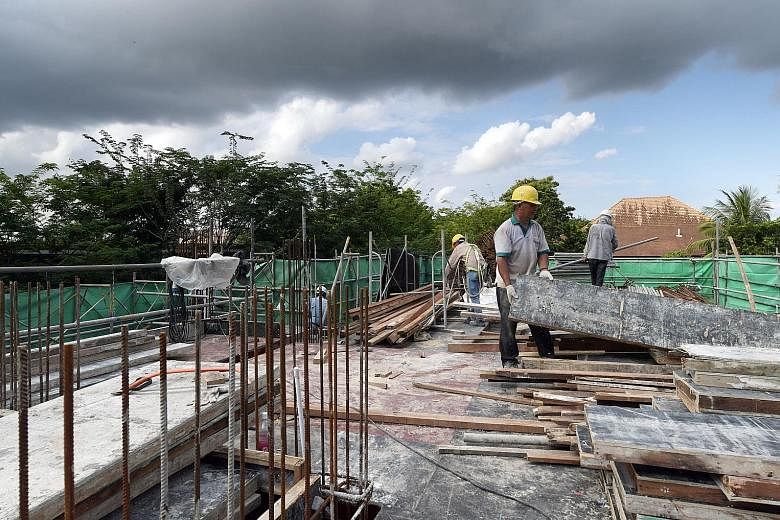For more than 15 years, Mr Fong went underground.
As the founder of a construction firm that specialises in geotechnical engineering services, he toiled at making sure that the soil is stable enough to be built on. But a few years ago, he threw in the towel.
"Contract prices were dropping to such low levels and profits were paper-thin. It was highly risky to take on such business," Mr Fong, who is in his 60s, told The Straits Times.
He merged his firm with another construction company, transferring 15 workers to the new firm.
"With bad debts and other payment issues, what room is there left to make investments in workplace safety, productivity enhancements and manpower training?" rued Mr Fong, who declined to give his full name.
It is a lament that is rising in volume in the construction industry, which has been hit on several fronts - a dwindling stream of contracts, rising competition from overseas, and tightened control on the use of cheap foreign workers.
Now, some construction firms fear that a massive push by the Government - also the biggest client for the industry - to get them to adopt new technologies might squeeze them out of business.
In recent years, the Building and Construction Authority (BCA) announced a string of initiatives to nudge firms to adopt prefabrication technology and reduce reliance on workers.
-
8,000
Number of small and medium-sized contractors in Singapore
Last month, outgoing BCA chief executive John Keung said there are plans to further cut foreign manpower in the sector by 20 to 30 per cent by 2020, though the authority later clarified that he meant to say that a higher-skilled workforce will be able to generate 20 to 30 per cent more construction output.
Other announcements ranged from requiring the use of labour-saving methods for tunnelling projects to increasing the weightage that public-sector tenders give to firms that have adopted the new technology.
But construction firms are saying that while this is the right direction to go in the long term, they fear smaller firms are being nudged over the cliff.
The change is happening too hard and too fast, they say, citing key challenges such as cost and lack of trained manpower.
Madam Gwee Sung is the director of Chong Tong Construction, which hires 40 workers, of whom 15 are Singaporeans. She said: "With the housing market in a downturn right now, it is a difficult time to adopt any new technologies or methods. We are already feeling the squeeze."
In particular, smaller firms are feeling the vise tightening. Figures on how many small and medium-sized contractors have shuttered are not available, but closures have not been uncommon in recent years.
Singapore Contractors Association (SCAL) president Kenneth Loo said: "When the market is bad and the environment is challenging, firms may not think it is worthwhile to continue."
There are about 8,000 small and medium-sized contractors here, according to BCA's registry system.
The biggest challenge, say those interviewed, is cost.
New technologies include building information modelling (BIM) and design for manufacturing and assembly (DfMA).
Such techniques may be about 10 per cent more expensive than conventional building methods in the initial years of adoption.
But there is some help at hand.
In response to queries from ST, the BCA outlined the incentives under the Construction Productivity and Capability Fund (CPCF) to help firms defray costs. It has committed over $450 million of the fund that will benefit more than 9,000 companies - 90 per cent of which are small and medium-sized firms, BCA added. They can use it for productivity efforts, from training of workers to investment in automation.
Under the CPCF, companies can offset up to 70 per cent of the cost premium of adopting DfMA, such as prefabricated prefinished volumetric construction, with a maximum funding of $10 million per application.
A similar incentive is offered for investment in BIM - such as on hardware, software and training - up to a cap of $30,000 per application, BCA said.
Singapore-listed Lian Beng Group construction director Than King Huat said: "The issue is how to make sure everyone in the entire ecosystem adopts the changes... but it may still be challenging for small firms because it is costly."
Another area of concern is the shortage of manpower trained in the new technologies.
Mr Than said hiring an operator to work the BIM system could cost $4,000 to $5,000 a month. A firm may need several of them as an operator can handle just one or two projects at a time, owing to the complexity of the work. For small companies, the costs may be a barrier.
Thus, the work is clearly cut out for new BCA chief executive Hugh Lim, who assumed the role this month. He told ST an immediate priority is to chart the sector's development "to raise the competitiveness of our firms and workforce, not just within Singapore but internationally".
"Smaller firms, in particular, must look to specialise to gain a competitive advantage, and consolidate or partner other firms to achieve scale for overseas ventures," BCA added.
Funding support aside, industry players say the Government can also help by bringing forward some public-sector projects.
SCAL hopes grants or tax rebates could be offered to large companies to encourage collaboration with small and medium-sized contractors.
SEE HOME


